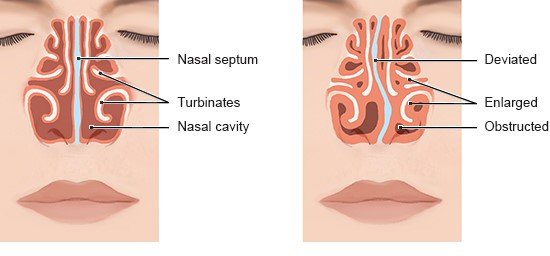Deutsche Gesellschaft für Hals-Nasen-Ohren-Heilkunde, Kopf und Hals-Chirurgie (DGHNOKHC). Formstörungen der inneren und / oder äußeren Nase (mit funktioneller und/oder relevanter ästhetischer Beeinträchtigung) (S2k-Leitlinie). AWMF-Registernr.: 017-070. 2020.
Papadopoulou AM, Chrysikos D, Samolis A et al. Anatomical Variations of the Nasal Cavities and Paranasal Sinuses: A Systematic Review. Cureus 2021; 13(1): e12727.
Pschyrembel Online. 2022.
Teixeira J, Certal V, Chang ET et al. Nasal Septal Deviations: A Systematic Review of Classification Systems. Plast Surg Int 2016; 2016: 7089123.
Thurnher D, Grasl MC, Erovic BM et al. HNO-Heilkunde: Ein symptomorientiertes Lehrbuch. Wien Springer; 2011.
Van Egmond MH, Rovers MM, Hannink G et al. Septoplasty with or without concurrent turbinate surgery versus non-surgical management for nasal obstruction in adults with a deviated septum: a pragmatic, randomised controlled trial. Lancet 2019; 394(10195): 314-321.
Van Egmond MH, Rovers MM, Tillema AH et al. Septoplasty for nasal obstruction due to a deviated nasal septum in adults: a systematic review. Rhinology 2018; 56(3): 195-208.
Zenner HP. Kurzlehrbuch Hals-Nasen-Ohren-Heilkunde. Lernbuch für Studierende. Berlin: epubli; 2013.
IQWiG health information is written with the aim of helping people understand the advantages and disadvantages of the main treatment options and health care services.
Because IQWiG is a German institute, some of the information provided here is specific to the German health care system. The suitability of any of the described options in an individual case can be determined by talking to a doctor. informedhealth.org can provide support for talks with doctors and other medical professionals, but cannot replace them. We do not offer individual consultations.
Our information is based on the results of good-quality studies. It is written by a team of health care professionals, scientists and editors, and reviewed by external experts. You can find a detailed description of how our health information is produced and updated in our methods.


